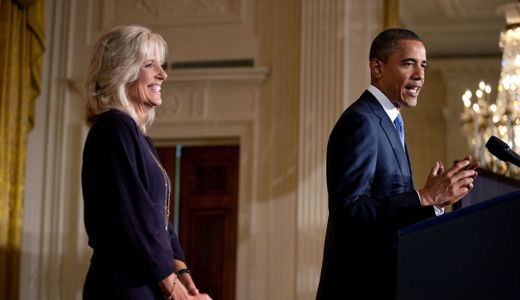
President Barack Obama hosted a White House summit on community colleges yesterday, aimed at strengthening the institutions that, with more than 8 million students, are the largest section of the U.S. higher education system.
Obama opened the Oct. 5 conference with a warning. The Republican Party’s education funding plans, he said, could jeopardize not only the aspirations of millions of students, but the future of the U.S. overall.
The Republican plan, the president noted, would cut education funding by 20 percent, while giving $700 billion in tax cuts to the richest 2 percent of the American population – an average of $100,000 for each of the richest people in the country.
“Think about it,” Obama said, alluding to the two fastest rising economies in the world. “China isn’t slashing education by 20 percent right now. India is not slashing education by 20 percent.”
Jobs requiring at least an associate’s degree will grow twice as fast as those requiring only a secondary education. And by 2020, about eight out of every 10 new jobs will require some form of higher education. Consequently, both the well being of the younger generation and the strength of the U.S. economy require that the education system be retooled. The administration hopes that the link between the needs of industry and those of students will move businesses to play a positive role in this area.
The purpose of the summit was to bring together national leaders, students, business leaders and others to find new paths to finance and strengthen community colleges, including through public-private partnerships. The hope was that the gathering would help meet the administration’s goals for higher education – to ensure that, by 2020, the U.S. moves from ninth to first place in percentage of college graduates worldwide and that community colleges produce an additional 5 million graduates yearly.
The White House argues that community colleges occupy a strategically important spot in boosting higher education for several reasons: low tuition, open admission policies and, according to a White House briefing memo, “because they are particularly important for students who are older, working or need remedial classes.” Community colleges are also the most flexible institutions in higher education, the White House notes, as they “work with businesses, industry, labor and government to create tailored training programs” to meet the most pressing needs.
Obama highlighted steps already taken by his administration. Over the next four years, $2 billion will be distributed to community colleges through the Career Training Initiative. The stimulus bill earmarked more than $3.5 billion in Pell Grants for low-income students, and pushed $1 billion to work training programs and $40 million in work study funds.
Underscoring the importance Obama attached to the summit, several high-ranking members of his administration were on hand, including Secretary of Labor Hilda Solis and Mike McMullen, chair of the Joint Chiefs of Staff.
Also in attendance were business and community leaders as well as community college students.
The summit was pulled together at the president’s request by Dr. Jill Biden. Dr. Biden herself teaches at Northern Virginia Community College, and has been a teacher for more than 30 years. She is married to Vice President Joe Biden.
Right now, as Obama pointed out, public education remains in crisis, including the community colleges. “Many of these schools are under pressure to cut costs and to cap enrollments and scrap courses even as demand has soared,” the president said. Much of this has to do with decisions made by state legislatures.
In New York, for example, state funding for community colleges has been slashed by $69.6 million in the past two years.
According to Barbara Bowen, president of the Professional Staff Congress, which represents City University of New York faculty, “Any serious consideration of the plight of community colleges should begin with their underfunding from state and local sources.”
State schools need “more money to retrain displaced workers, to keep class sizes under control, to protect access and to keep college affordable,” said Fran Clark, of the New York Public Interest Research Group. She hailed Obama’s actions at the national level, saying that his “leadership can help make community colleges a real priority for our city and state leaders.”
At the summit, Dr. Biden said that ultimately, the fight for higher education is the fight to better the lot of America’s working people. “I’m inspired by students who overcome significant odds just to show up,” she said, “workers who have returned to school to improve their job prospects, mothers who juggle jobs and childcare while preparing for a new career, and students who spend two years at a community college before transferring to a four-year school.”
As part of the summit, the White House unveiled a new video, calling community colleges “America’s best kept secret.”
Photo: Dr. Jill Biden and President Barack Obama at the White House summit on community colleges, Oct. 5. (whitehouse.gov)










